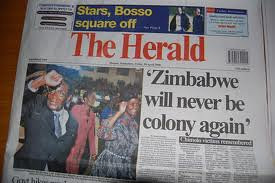
The Zimbabwe Herald is the leading state newspaper in the Southern African state. The headline reveals its anti-imperialist political character., a photo by Pan-African News Wire File Photos on Flickr.
Wednesday, 27 February 2013 00:00
Felex Share Herald Reporter
THE Herald continues to rule the roost as Zimbabwe’s most-read daily, despite a further decline in readership in most stables.
Latest Zimbabwe All Media and Products Survey results released yesterday show that overall newspaper readership dropped from 47 percent to 44 percent between 2011 and 2012.
The results are for the last quarter of last year.
The Herald maintained pole position with a 25 percent readership, down from 31 percent in the survey conducted between July and September last year.
Its readership stood at 1 681 939 in the past three months with 936 430 of those being in urban areas while 745 509 readers are in rural areas.
The Herald is followed by H-Metro whose readership rose from 14 percent to 17 percent, with a readership of 1 173 244.
Readership for both the Daily News and NewsDay dropped from 22 percent in the last survey to 13 percent.
The Daily News’ readership was at 872 605 while the Newsday had 901 148 readers.
The Herald’s sister paper, Chronicle had a readership of eight percent from 13 percent in the last results.
The Chronicle had 566 712 readers for the period under review.
In the last four weeks, 555 904 people have been tuning to Star FM with Power FM still the most popular urban station with 2 138 221 listeners, which is 32 percent of total listenership.
ZiFM has 391 223 listeners (six percent) and Radio Zimbabwe is the most popular station countrywide with 2 688 403 listeners (40 percent).
National FM has 698 320 listeners (10 percent), Spot FM had 214 330 (three percent) while Studio 7’s listenership stood at 133 843 (two percent).
Overall, there has been an increase in the number of people who listen to the radio during the past month, at 61 percent.
The growth has come from the new stations Star FM and ZiFM.
In urban areas, 15 percent tune in to Star FM and nine percent to ZiFM while they both enjoy listener-ship of four percent out of town.
The Sunday Mail remains the most-sought-after weekly paper.
It attracts 1 075 078 (16 percent) readers countrywide while Manica Post is a distant second with 316 089 (five percent) readers.
They were followed by the Sunday News and Kwayedza with 208 091 (three percent) and 201 539 (three percent) readers countrywide.
For the period under review, The Standard has 203 610 (three percent) readers while B-Metro has 186 958 (three percent) readers.
Financial Gazette had a readership of 100 913 (one percent) while Zimbabwe Independent had 76 988 readers.
Umthunywa and the Daily News on Sunday were tied on one percent, but the former had more readers than the latter.
The Bulawayo paper had 86 593 readers as compared to the Daily News on Sunday’s 43 351.
The Voice’s readership stood at 3 431.
The survey revealed that despite the reduction in the free-to-air footprint, satellite TV viewership rose three points to 41 percent of the population.
ZTV has a viewership of 32 percent while urban homes with a satellite dish rose from 68 percent to 70 percent.
People watching ZBC TV2 increased significantly, rising from four to nine percent nationally.
It also rose from eight to 17 percent in towns and cities.
Audiences watch the news most - 16 percent nationally and 17 percent in towns - after which they enjoy local drama, watched by seven percent of the population.
SABC channels remain the most popular satellite, down three percent to 29 percent.
Satellite TV is watched by half the urban population and 16 percent of rural folk.
Supersport enjoyed a two percent rise to seven percent of Zimbabweans.
Urban Internet use is growing fast with 42 percent of people having access to it, up from 34 percent a year ago.
Total internet access is 22 percent recording a four percent rise.
The most common vehicle is smart-phones, 16 percent nationally and 32 percent in towns.
Facebook is the most popular website, visited by 15 percent of Zimbabweans and 31 percent of city dwellers, followed by Google (10 percent) and Yahoo (four percent).
Cellphone usage continues to grow – 85 percent of Zimbabweans having one while rural access has increased to 80 percent from 66 percent in the same quarter in 2012.
Research Bureau International carried out the survey on behalf of the Zimbabwe Advertising Research Foundation.
ZARF, whose board includes representatives from the media and advertising industries, is funded by a 1,5 percent surcharge on all advertising and is independent of control by any media house or agency.
The foundation then hires an independent market research company to do the actual survey.
Major advertising agencies set up the system to find out how many people read each newspaper, watch television, listen to radio or access the Internet.
The Herald has consistently come out tops in the survey carried by various organisations.
No comments:
Post a Comment